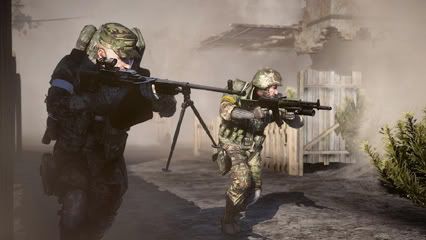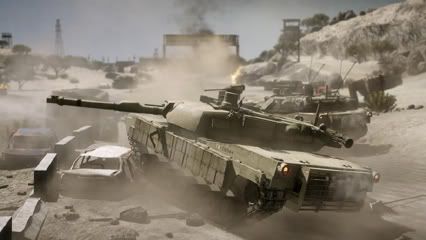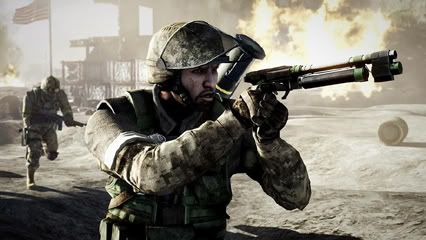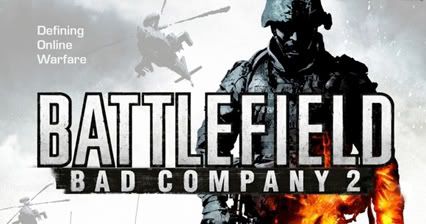- Format: Xbox 360 (version reviewed), PS3, PC
- Unleashed: Out Now
- Publisher: EA
- Developer: DICE
- Players: 1 (single-player), 2-24 (multiplayer)
- Site: badcompany2.ea.com
The arms race to outdo Modern Warfare 2 is heating up. FPS developers like DICE are jumping at the chance to capture the magic of that game’s insane set-pieces. Battlefield: Bad Company 2 is the first to the plate, offering a single-player campaign that feels frighteningly similar to the globe-trotting thrill-ride we tackled only a few months ago. If that were all Bad Company 2 had to offer, it’d be little more than a sad copycat. Thankfully, the Battlefield series is multiplayer at heart, and scratches a much different itch than its modern combat competitor.
Let’s just get it out of the way: Bad Company 2’s campaign isn’t amazing. It’s not bad, and in fact right from the start it sprinkles in some unique and exciting scenes. But it doesn’t do enough to separate itself from Modern Warfare 2. The similarities are uncanny – you’ll run through shanty towns in Chile, nearly freeze to death in the mountains, and take on a Russian terrorist looking to hit the US with some new-fandangled WMD. It’d be one thing if that were the extent of it, but even the gameplay strays from the sandbox style the series is known for. Missions are incredibly directed, linear, and simply don’t play to DICE’s strengths.
When the whole thing is over in a few hours, it becomes pretty clear where this game’s focus is. Bad Company 2 offers 24 player, class and objective-based multiplayer in gigantic environments. In many ways, it’s just another Battlefield game – large-scale combat, vehicles, capture points, and general insanity are all present and accounted for. The difference is that Bad Company 2 feels more focused and rewarding than ever.
 Teamwork is key, as is knowing your role. BC2 offers four classes to choose from, each fulfilling multiple roles. Not only is each one specialized, but an important cog in a fully functioning team. The fact that there’s no “just go shoot dudes” class should tell you what kind of game this is.
Teamwork is key, as is knowing your role. BC2 offers four classes to choose from, each fulfilling multiple roles. Not only is each one specialized, but an important cog in a fully functioning team. The fact that there’s no “just go shoot dudes” class should tell you what kind of game this is.
The four classes seem standard at face value, but the extra wrinkles become clear as you play. The assault class is the closest you get to the typical soldier, but their ability to drop ammo is invaluable and their grenade launcher is great for opening up new paths in the destructible environments. The medic can drop health kits and resuscitate fallen comrades, but they also pack LMGs for laying down covering fire. Engineers aren’t much of a threat in foot combat, but they’re a blessing and a curse for vehicles, capable of repairing and destroying in equally potent measure. Lastly, the recon class spices up the typical sniper, giving them long-range mortar strikes that make them a force to be reckoned with (and possibly the focus of later balance tweaks).
In a coordinated team, the play between the different classes is a sight to see. Most of the magic moments come when a team is operating in tandem, using their squad abilities. The game keeps its action tight by dividing teams into squads. As long as you’re a part of a 2-4 player squad, you can spawn right next to them. Smart squads can hold the line as long as they keep one squadmate alive.
 Bad Company 2 employs a Modern Warfare-style progression system, unlocking new equipment as you score points. It works as a bare-bones tutorial, locking out certain concepts while you learn the basics. It seems smart in theory, but it’s somewhat frustrating in practice. Once you’ve learned the ins and outs of your own class, you’ll probably be familiar with the other classes just from watching your friends. But until you’ve unlocked all the major equipment for a class they’re essentially useless. To make matters worse, it can take several hours to unlock the key equipment for all classes. Instead, DICE should have had these items available from the start or had them unlock much more quickly.
Bad Company 2 employs a Modern Warfare-style progression system, unlocking new equipment as you score points. It works as a bare-bones tutorial, locking out certain concepts while you learn the basics. It seems smart in theory, but it’s somewhat frustrating in practice. Once you’ve learned the ins and outs of your own class, you’ll probably be familiar with the other classes just from watching your friends. But until you’ve unlocked all the major equipment for a class they’re essentially useless. To make matters worse, it can take several hours to unlock the key equipment for all classes. Instead, DICE should have had these items available from the start or had them unlock much more quickly.
This isn’t a methodical Tom Clancy game, but it feels more genuine than most online shooters. Everything feels substantial and weighty. Whether it’s the walls crumbling around you, the arc of a distant sniper bullet, or the threat of an incoming vehicle, there’s solid and satisfying physics backing it all up. The sound design is also incredible, with the thundering bass of explosions and heavy machine guns echoing around the battlefield. Bad Company 2 has some unrealistic elements, but the feeling that you’re in the thick of an epic battle is palpable.
If it’s not already abundantly clear, this is a team-oriented game. Each gametype demands a mix of attack and defense, leveraging your class abilities, spotting enemies for teammates (using the back or select button – odd placement to be sure), and generally communicating. This focus is both a blessing and a curse. It requires more than just hopping into a match and hoping for the best. In fact, if you’re not playing with at least one full squad of friends, you’re probably not going to enjoy yourself. Without solid teams on both sides, a match quickly devolves into a one-sided trouncing. If you’re not willing to put in that extra social networking to gather a team, the game’s matchmaking system isn’t going to do you any favors.
 That said, a good match in Bad Company 2 is a much bigger deal than it is in most shooters. With so many players, so much action, and so many variables, the epic level of combat on display is unparalleled. If you’re willing to put in the effort, it will reward you with countless memorable moments.
That said, a good match in Bad Company 2 is a much bigger deal than it is in most shooters. With so many players, so much action, and so many variables, the epic level of combat on display is unparalleled. If you’re willing to put in the effort, it will reward you with countless memorable moments.
Battlefield Bad Company 2 is not for everyone. It’s a poor single player game, and it doesn’t offer the grand buffet of gameplay modes found in other shooters like Halo and Modern Warfare. That said, if you’re looking for a multiplayer shooter with depth, that requires teamwork, and feels different from its contemporaries, Bad Company 2 may have a place on your shelf.
7/10








Comments